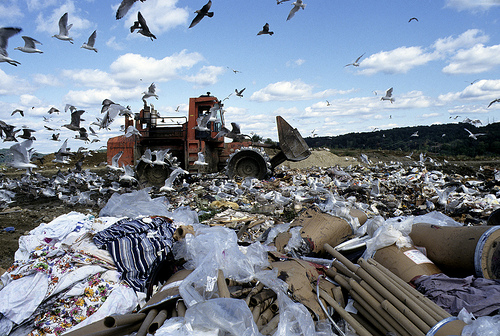 Photo: United NationsGarbage. It’s wonderful stuff. You can do so much with it! Harvest gas from it to fuel your airplanes, build a boat out of it and sail around the world, or make a giant junk mosaic. Heck, if you’re plucky enough, you can feed a family on the stuff. If it gets too stinky, blast it with giant deodorant guns! “Waste management” kept groceries in Tony Soprano’s fridge, no?
Photo: United NationsGarbage. It’s wonderful stuff. You can do so much with it! Harvest gas from it to fuel your airplanes, build a boat out of it and sail around the world, or make a giant junk mosaic. Heck, if you’re plucky enough, you can feed a family on the stuff. If it gets too stinky, blast it with giant deodorant guns! “Waste management” kept groceries in Tony Soprano’s fridge, no?
But you know what they say about too much of a good thing. When the garbage piles up, it can be bad news. Remember the Chicago couple who were buried alive under their own refuse? That was a bad day. Tons of our discarded plastic ends up floating around the ocean, and the impact of all that refuse falls disproportionately on poor people.
So it was welcome news yesterday when Mexico City announced it had closed the Bordo Poniente Landfill, one of the world’s largest, where some 70 million tons of trash are piled over more than a square mile of land adjacent to the airport. The dump had been leaking nasties, pumping out greenhouse gases, and generally causing a nuisance for years.
The closure was a partnership with the C40 Cities Climate Leadership Group and the Clinton Climate Initiative. In official statements, C40 head and New York City Mayor Michael Bloomberg and former President Bill Clinton rolled out the grand pronouncements. “Closing Mexico City’s Bordo Poniente Landfill is one of the most important environmental actions for the entire country,” declared Mexico City Mayor Marcelo Ebrard.
True, that: Backers say closing the dump could cut Mexico City’s greenhouse-gas emissions by a jaw dropping 25 percent. In the future, the city could harvest gas from the trash that’s already there, burning the gas to produce enough electricity to power 35,000 homes and sparing the planet the equivalent of 25 million tons of CO2 over a quarter century.
“It’s huge,” says Karen Luken, the global director of the waste management program for C40. “What may be the world’s largest landfill is closed.”
The story doesn’t end there. Mexico City’s almost 9 million residents still generate a tremendous amount of trash, and it has to go somewhere. In the past few years, the city has dramatically increased recycling efforts, and much of the city’s organic waste is being diverted to a composting facility. The city is in the process of making a formal agreement with the hundreds of people currently scavenging a living from the dump, enlisting them to sort through recyclables and compostables.
Still, only about half of the city’s garbage can be “diverted” from dumps. The rest will now go to private landfills outside the city, Luken says.
The United States is no stranger to the garbage dilemma, of course. According to the EPA, the average American throws away four pounds of material each day — and that doesn’t factor in the waste that went into producing all of our crap. And while we’re reusing and recycling more now than we did in decades past, a whole lot of this stuff still ends up at the dump.
New York City closed the Fresh Kills Landfill on Staten Island in 2000. Fresh Kills was more than twice as large as Bordo Poniente and a mammoth headache for nearby residents. Its closing was hailed as a major victory for public health, and the site is now being turned into a park. Like Mexico City, New York now diverts some of its waste for recycling and other uses, but it also exports tons of garbage to other states.
Luken says much of our non-recyclable waste can be converted into electricity via nifty technologies such as waste gasification (which uses heat to turn garbage into methane and other gases), plasma arc (which basically does the same, using electricity), and anaerobic digestion (using microorganisms). These technologies are coming into mainstream use in some parts of Europe, but they’re expensive, and for the time being, at least, we Americans seem to think we’ve got more space to pile our garbage than we do money to build whizbang waste energy facilities.
In the meantime, Luken says, efforts are underway to reduce waste by charging people for what they throw away, providing incentives for recycling, and requiring companies to take back their products once consumers are finished with them.
Who knows? Maybe some day, we’ll put the “waste managers” out of business — or at least make the business look a whole lot different than it does today. As Tony Soprano once said, “This day and age? Who wants the fuckin’ job?”



